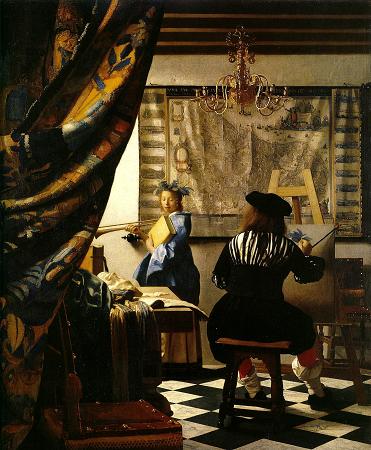Painting. Painting is the practice of applying paint, pigment, color or other medium to a solid surface. The medium is commonly applied to the base with a brush, but other implements, such as knives, sponges, and airbrushes, can be used. The final work is also called a painting. Painting is an important form in the visual arts, bringing in elements such as drawing, gesture, composition, narration, or abstraction. Paintings can be naturalistic and representational, photographic, abstract, narrative, symbolistic, emotive, or political in nature. A portion of the history of painting in both Eastern and Western art is dominated by religious art. Examples of this kind of painting range from artwork depicting mythological figures on pottery, to Biblical scenes Sistine Chapel ceiling, to scenes from the life of Buddha or other images of Eastern religious origin. In art, the term painting describes both the act and the result of the action. The support for paintings includes such surfaces as walls, paper, canvas, wood, glass, lacquer, pottery, leaf, copper and concrete, and the painting may incorporate multiple other materials including sand, clay, paper, plaster, gold leaf, as well as objects. Color, made up of hue, saturation, and value, dispersed over a surface is the essence of painting, just as pitch and rhythm are the essence of music. Color is highly subjective, but has observable psychological effects, although these can differ from one culture to the next. Black is associated with mourning in the West, but in the East, white is. Some painters, theoreticians, writers and scientists, including Goethe, Kandinsky, and Newton, have written their own color theory. Moreover, the use of language is only an abstraction for a color equivalent. The word red, for example, can cover a wide range of variations from the pure red of the visible spectrum of light. There is not a formalized register of different colors in the way that there is agreement on different notes in music, such as F or C♯. For a painter, color is not simply divided into basic and derived colors. Painters deal practically with pigments, so blue for a painter can be any of the blues: phthalocyanine blue, Prussian blue, indigo, Cobalt blue, ultramarine, and so on. Psychological and symbolical meanings of color are not, strictly speaking, means of painting. Colors only add to the potential, derived context of meanings, and because of this, the perception of a painting is highly subjective. The analogy with music is quite clear, sound in music is analogous to light in painting, shades to dynamics, and coloration is to painting as the specific timbre of musical instruments is to music. These elements do not necessarily form a melody of themselves; rather, they can add different contexts to it. Modern artists have extended the practice of painting considerably to include, as one example, collage, which began with Cubism and is not painting in the strict sense. Some modern painters incorporate different materials such as sand, cement, straw, leaves or wood for their texture. Examples of this are the works of Jean Dubuffet and Anselm Kiefer. There is a growing community of artists who use computers to paint color onto a digital canvas using programs such as Adobe Photoshop, Corel Painter, and many others. These images can be printed onto traditional canvas if required. Jean Metzinger's mosaic-like Divisionist technique had its parallel in literature; a characteristic of the alliance between Symbolist writers and Neo-Impressionist artists: I ask of divided brushwork not the objective rendering of light, but iridescences and certain aspects of color still foreign to painting. I make a kind of chromatic versification and for syllables I use strokes which, variable in quantity, cannot differ in dimension without modifying the rhythm of a pictorial phraseology destined to translate the diverse emotions aroused by nature. Rhythm, for artists such as Piet Mondrian, is important in painting as it is in music. If one defines rhythm as a pause incorporated into a sequence, then there can be rhythm in paintings. These pauses allow creative force to intervene and add new creations, form, melody, coloration. The distribution of form, or any kind of information is of crucial importance in the given work of art, and it directly affects the aesthetic value of that work.
more...







